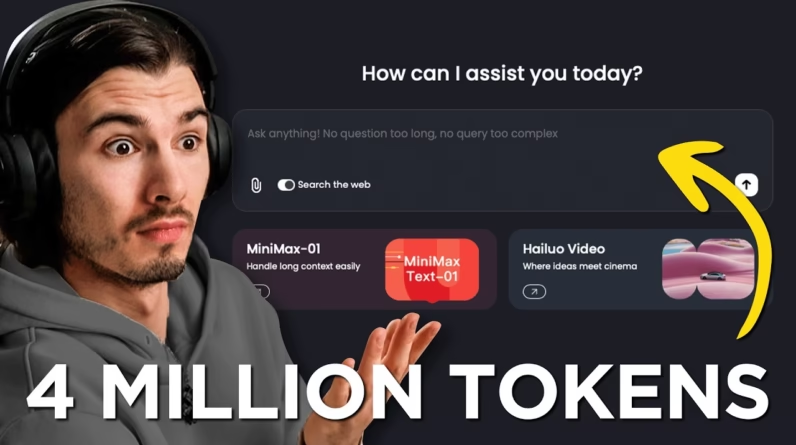
Explore the world of no-code platforms designed specifically for empowering non-developers. This article presents insights into seven innovative AI automation services that can help you kickstart your journey in building your own AI automation agency. Each of these services is perfect as a lead offer to attract potential clients, making it easier for you to enter this exciting field without needing extensive coding skills.
Learn how these services operate and the actionable tips that will guide you in effectively delivering them to clients. By focusing on practical applications, this article provides a clear roadmap for beginners looking to succeed while avoiding the common pitfalls that can slow down progress. From automated referral systems to personalized shopping assistants, you will discover opportunities to set up a thriving agency and create value for various businesses.
Table of Contents
No-Code Development: Empower Your Creativity Without Coding Skills!
Introduction to No-Code Development
Definition and Purpose of No-Code Platforms
No-code development refers to a methodology that allows you to create applications, websites, and workflows without requiring in-depth programming skills. Instead of writing lines of code, you rely on visual interfaces, drag-and-drop elements, and pre-built templates to build functional products. This approach democratizes software development, enabling you—whether you’re a marketer, designer, entrepreneur, or just a curious individual—to bring your ideas to life without needing to learn complex coding languages.
The Rise of No-Code Solutions in the Tech Industry
In recent years, the tech industry has experienced a significant shift towards no-code solutions. The surge in demand for rapid development and deployment solutions, especially during the digital transformation spurred by the pandemic, has paved the way for no-code platforms to shine. Now more than ever, you can conquer the digital landscape, pushing out apps and websites faster and more efficiently than traditional coding allows. This rise is not just a trend; it’s changing how businesses operate, making technology accessible to a wider audience.
Key Benefits for Non-Developers
As a non-developer, you stand to gain immensely from no-code platforms. The most prominent benefits include:
- Lower Barriers to Entry: You don’t need to invest years learning to code.
- Faster Prototyping: Launch your ideas swiftly and iterate based on user feedback.
- Cost-Effective: Save on hiring expensive developers if your budget is tight.
- Empowerment: You can innovate and solve problems directly without needing to rely on technical teams.
Top No Code Platforms of 2024
Overview of Leading No-Code Platforms
As we step into 2024, several no-code platforms are leading the charge, each with its unique features and capabilities. Some of the top contenders include Webflow, Bubble, Adalo, and Glide. Each platform offers a distinct set of tools allowing you to create everything from websites to mobile apps while catering to different user needs.
Comparison of Features: Webflow, Bubble, Adalo, and Glide
-
Webflow: Primarily focused on web design, Webflow combines design and development by allowing you to create responsive websites visually. It offers CMS capabilities, animations, and SEO-friendly features.
-
Bubble: This is a robust platform designed for building complex web applications. Bubble provides a drag-and-drop editor and powerful workflows to define the app’s logic, making it great for launching MVPs.
-
Adalo: Adalo puts emphasis on mobile app development. With its easy-to-use interface, you can create custom apps with functionalities such as notifications, databases, and user authentication.
-
Glide: Glide specializes in turning Google Sheets into mobile apps. It’s a fantastic option for simple app creation, especially if you have data organized in spreadsheets.
Pros and Cons of Each Platform
-
Webflow
- Pros: High-quality designs, responsive, excellent for CMS.
- Cons: Steeper learning curve, not suitable for full-fledged apps.
-
Bubble
- Pros: Allows complex app creation, flexible workflows.
- Cons: Performance issues with larger apps, may overwhelm beginners.
-
Adalo
- Pros: Easy mobile development, straightforward user interface.
- Cons: Limited design customization, less supportive community.
-
Glide
- Pros: Quick setup, integrates well with Google Sheets.
- Cons: Not suitable for complex functionalities, limited to mobile.
Best Use Cases for Different Platforms
- Webflow: Perfect for portfolio sites, e-commerce, and marketing sites.
- Bubble: Ideal for startups needing MVPs or SaaS products.
- Adalo: Great for fitness, scheduling, and simple utility apps.
- Glide: Best for data-driven apps such as directories or lists.
How to Choose the Right No Code Platform
Identifying Project Requirements
Before diving in, you need clarity on what you want to achieve with your project. Define the functionalities, target audience, and the kind of user experience you envision. This will guide you in picking a platform that suits your needs.
Evaluating Budget Constraints
Budget plays a crucial role in selecting the right platform. Some platforms may charge higher fees for additional features, while others offer free versions with limitations. Analyze each platform’s pricing plans against your budget to find the best fit.
Assessing User Experience and Ease of Use
Your comfort level with the platform is paramount. Spend some time exploring each platform’s interface through demos and tutorials. Choose one that feels intuitive for you, as a smooth learning process is crucial for your success.
Integration Options with Other Tools
Consider what other tools you currently use or plan to incorporate into your system. Check if the no-code platform integrates seamlessly with these tools—like CRMs, email marketing software, or payment processors—to create a cohesive ecosystem.

No Code Platform Reviews
Detailed Reviews of Webflow
Webflow stands out for its hybrid approach to web design and development. With a focus on visual design, you can create stunning, responsive layouts. It also incorporates a CMS that allows for content updates without writing code. However, the learning curve can be a challenge for newcomers.
In-Depth Analysis of Bubble
Bubble is known for its powerful capabilities in app creation. It allows you to design everything from user interfaces to back-end databases. The visual programming interface enables you to create complex interactions without coding. The downside, though, is that the platform can become sluggish as applications grow in size and complexity.
Exploration of Adalo Features
Adalo simplifies mobile app development with its drag-and-drop interface. You can design custom layouts and add functionalities like user logins and notifications. It’s particularly useful for those looking to get a simple app off the ground quickly but may not satisfy those needing advanced features.
Overview of Glide and Its Capabilities
Glide is distinctive in recruiting data from Google Sheets, making it super convenient for users familiar with spreadsheet functions. With its straightforward setup, you can create a functional app in minutes. However, it’s more limited when it comes to more in-depth logic or database capabilities.
Building Websites with No-Code Tools
Step-by-Step Guide to Using Webflow
- Create Your Account: Sign up on the Webflow website.
- Choose a Template: Pick a template that fits your project.
- Customize Design: Use the drag-and-drop editor to adjust layouts, colors, and fonts until it matches your brand.
- Add Content: Insert your texts, images, and any other media.
- Set Up CMS: If required, configure the CMS for dynamic content.
- Publish: After testing for responsiveness, publish your site.
Creating Landing Pages in Bubble
- Sign Up: Register on Bubble.
- Choose a Project Type: Select a landing page template or start from scratch.
- Design Your Page: Use the visual editor to structure your page.
- Add Workflows: Identify actions (like button clicks) and set up corresponding workflows.
- Preview and Test: Check for responsiveness and functionality.
- Launch Your Page: Publish your landing page for the world to see!
Customizing Templates in Adalo
- Log In: Create an account on Adalo.
- Select a Template: Choose from a range of mobile app templates.
- Modify Layouts: Change colors, images, and components to fit your vision.
- Add Integrations: Incorporate any necessary APIs or tools for app functionality.
- Preview Your App: Run it through your mobile emulator.
- Publish: Prepare your app for launch!
Utilizing Glide for Quick Prototyping
- Sign Up for Glide: Create your account.
- Link Your Google Sheet: Connect Glide to your Google Sheets for data input.
- Build Your App: Use the GUI to design your app quickly.
- Test Functionality: Ensure everything works as expected.
- Share Your App: Publish and share your created app link!
Automating Workflows without Code
Introduction to Workflow Automation
Workflow automation lets you streamline repetitive tasks, saving you time and effort. With no-code tools, such as Zapier or Make, you can connect various apps and automate workflows, ensuring that your processes run smoothly without manual intervention.
Using Tools like Zapier with No-Code Platforms
Zapier integrates with countless applications, allowing you to create automated workflows known as “Zaps.” You can connect apps you use daily—like Gmail, Slack, and your favorite no-code platforms—to create artful efficiency in your processes.
Real-World Examples of Automated Workflows
Consider a scenario where you run a newsletter: each time a new user subscribes through your app, Zapier can automatically add them to your mailing list in Mailchimp and send them a welcome email. Or, if you’re running an e-commerce site, every time a purchase is made, you can automate an update to your inventory system.
Benefits of Automation for Non-Developers
Automating workflows empowers you to focus on high-value tasks rather than getting bogged down in the mundane. You can drive productivity, reduce errors, and free up valuable time to bring in more creative ideas or tackle more pressing projects.
No-Code Development for Mobile Apps
Creating Mobile Apps with Adalo
Adalo is fantastic for beginners wanting to create mobile apps without any coding. You can easily design beautiful apps with specified user types and integrated databases, allowing for dynamic interactions.
Integrating Features into No-Code Mobile Apps
In your mobile app, you can integrate multiple features such as push notifications, user authentication, and payment processing—all with a few clicks. Adalo’s easy interface ensures you don’t need to write a single line of code for these advanced functionalities.
Testing and Launching Your App
Prior to launching your app, thorough testing is a must. Utilize the preview function to ensure everything operates smoothly. After testing, you can publish directly from Adalo to app stores with minimal hassle.
Marketing Strategies for No-Code Apps
Once your app is ready and launched, consider investing in digital marketing strategies like social media promotion, influencer partnerships, or targeted ads to reach your potential users. Building a website or landing page can also aid in marketing efforts.
Community and Support for No-Code Users
Online Communities and Forums
Being part of a community can offer invaluable support for your no-code journey. Platforms like Reddit, Facebook groups, and Discord channels are filled with fellow no-code enthusiasts who share tips, resources, and encouragement.
Access to Tutorials and Learning Resources
Most no-code platforms provide a wealth of tutorials and documentation to help you get started. Websites like YouTube also offer hundreds of video tutorials tailored to various platforms and projects.
Sharing Projects and Gaining Feedback
Don’t be shy! Share your projects with online communities to get feedback. Engaging with fellow creators can provide insights you may not have considered and improve your final product.
Networking Opportunities in the No-Code Space
As the no-code movement grows, opportunities to network are increasing. Attend virtual events, webinars, or local meetups. Collaborating with others can lead to exciting projects or partnerships.
Challenges and Limitations of No-Code Platforms
Common Pitfalls to Avoid
While no-code platforms are amazing, there are pitfalls to watch out for. Make sure to set realistic expectations; while you can build quickly, the end product may not have the same customizability as a coded platform.
Understanding the Limitations of No-Code Solutions
No-code solutions usually have certain limitations concerning scalability, performance, or custom functionality. As you grow, you may find that what started as a perfect solution can become a bottleneck.
When to Consider Hiring a Developer
As your app or project scales, you might hit a wall where no-code can’t go further. In instances where more complex integrations, performance issues or custom backend logic becomes necessary, it’s time to consider hiring a developer.
Future of No-Code Development
The future of no-code looks bright! As technology advances, no-code platforms are continuously enhancing their functionalities, making it possible for anyone to innovate without technical barriers. Expect growth in community support, better features, and even more integrations.
Conclusion
Recap of the Benefits of No-Code Platforms
In summary, no-code development removes the barriers to creating engaging digital products. Whether you’re building a website, automating workflows, or launching a mobile app, the possibilities are endless with no-code tools.
Encouragement for Non-Developers to Explore No-Code Tools
If you’re new to technology or want to explore your creativity, now’s your time! Don’t let coding intimidate you—embrace no-code tools that empower your ideas and solutions.
Final Thoughts on the Future of App Development
As we move forward, remember that the no-code journey is yours to embrace. Explore, experiment, and create. The future of app development is not just for developers—it’s for you, too!







